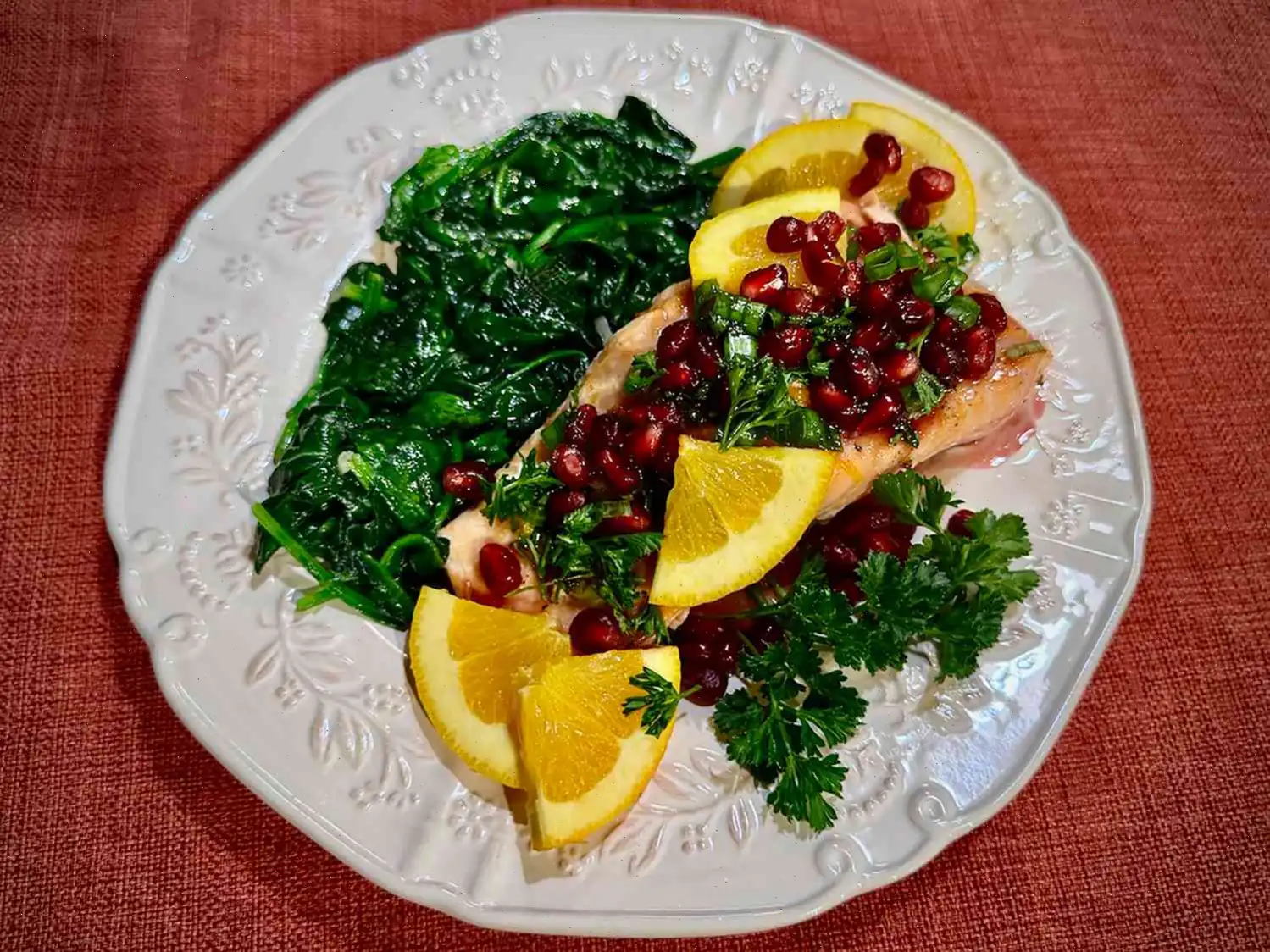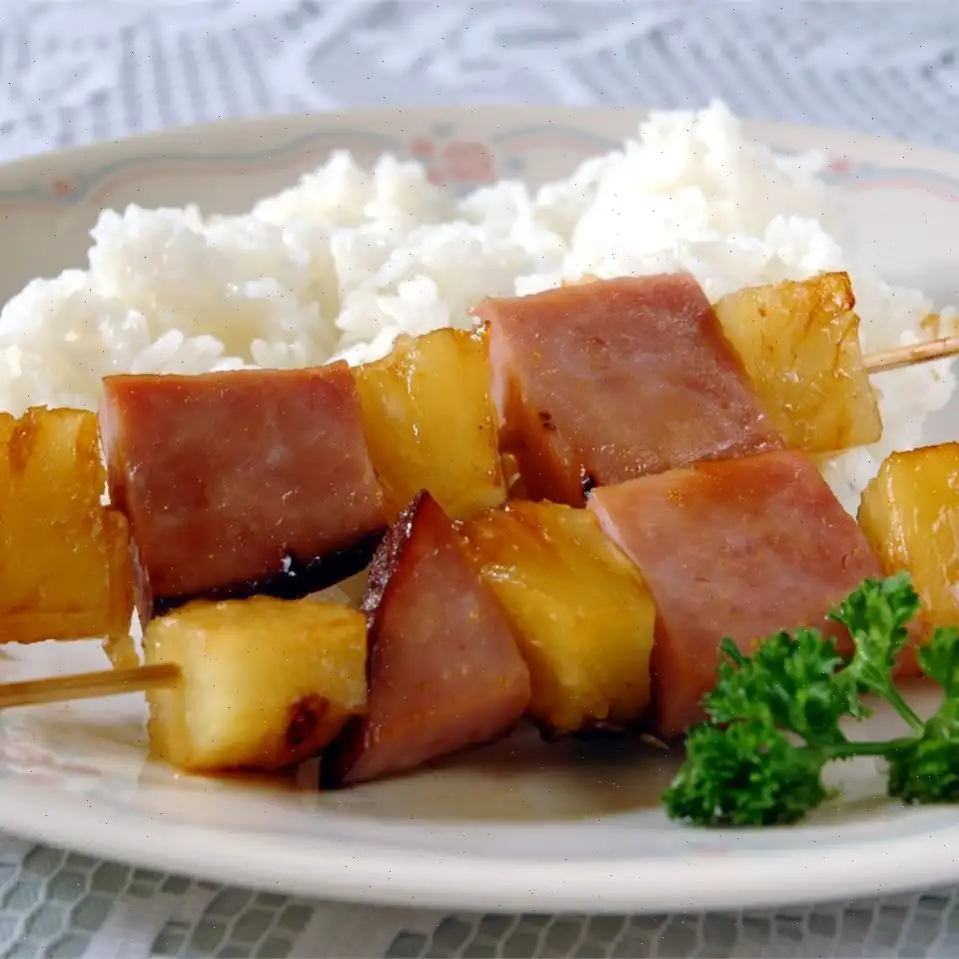
Pomegranate Glazed Salmon Recipe
Ingredients
- 4 (8 ounce) salmon fillets
- 1 tablespoon butter
- 2 teaspoons orange juice
- Salt and freshly ground black pepper, to taste
Pomegranate Drizzle
- 1 1/2 cups pomegranate juice
- 2 tablespoons brown sugar
- 2 tablespoons orange juice
- 1 pinch salt (optional)
Spinach
- 2 tablespoons olive oil
- 1 green onion, finely chopped
- 1 clove garlic, minced (or more to taste)
- 1 pound fresh spinach, torn
- Salt, to taste
- 1 cup pomegranate arils, or to taste
- 2 tablespoons fresh chopped parsley (for garnish, optional)
- 2 green onions, chopped (for garnish)
- 1/2 orange, sliced
- 1 tablespoon orange zest (for garnish)
Directions
- Preheat the oven to 375F (190C). Line a sheet pan with parchment paper.
- Place the salmon fillets on the prepared sheet pan, allowing them to come to room temperature.
- In a small bowl, stir together melted butter and orange juice. Brush the mixture over the salmon fillets, and season with salt and pepper.
- Bake the salmon in the preheated oven for 13 to 15 minutes, or until an instant-read thermometer inserted near the center of the fillets reads 145F (63C).
- Meanwhile, prepare the pomegranate drizzle: In a small saucepan over medium-high heat, combine pomegranate juice, brown sugar, orange juice, and salt. Bring to a boil and cook, stirring frequently, for about 10 minutes, until the mixture has thickened slightly. Remove from heat.
- For the spinach: Heat olive oil in a large skillet over medium heat until shimmering. Add the green onion and garlic, cooking and stirring until fragrant (about 30 seconds).
- Add the spinach to the skillet and cook, stirring occasionally, until wilted and still bright green, about 2 minutes.
- Transfer the spinach to a serving platter and arrange the salmon fillets on top.
- Drizzle the salmon with the pomegranate sauce and sprinkle with pomegranate arils.
- Garnish with fresh parsley, green onions, orange slices, and orange zest.
Nutrition Facts (per serving)
- Calories: 993
- Total Fat: 55g (70% Daily Value)
- Saturated Fat: 12g (58% Daily Value)
- Cholesterol: 232mg (77% Daily Value)
- Sodium: 596mg (26% Daily Value)
- Total Carbohydrates: 40g (15% Daily Value)
- Dietary Fiber: 6g (22% Daily Value)
- Total Sugars: 30g
- Protein: 84g (167% Daily Value)
- Vitamin C: 89mg (99% Daily Value)
- Calcium: 219mg (17% Daily Value)
- Iron: 5mg (27% Daily Value)
- Potassium: 2476mg (53% Daily Value)
* Percent Daily Values are based on a 2,000 calorie diet. Your daily values may be higher or lower depending on your calorie needs.
The Story Behind Pomegranate Glazed Salmon
Pomegranate glazed salmon is a modern fusion dish that combines the richness of salmon with the tangy sweetness of pomegranate, creating a sophisticated yet approachable entre. While salmon has been a staple in Northern European and North American cuisines for centuries, the use of pomegranate as a glaze draws inspiration from Middle Eastern culinary traditions, where pomegranate has been cultivated for over 5,000 years. This pairing reflects a growing trend in contemporary cuisine to blend flavors from different regions, balancing the natural oils of the fish with a fruity, slightly acidic glaze.
Regional Variations
Although commonly prepared in the United States and Western Europe, pomegranate glazed salmon has several regional twists. In Mediterranean versions, chefs often add fresh herbs like thyme or rosemary, while in Middle Eastern renditions, pomegranate molasses replaces juice for a deeper, more concentrated flavor. In the Pacific Northwest, where salmon is abundant, the dish is often complemented with locally sourced greens and citrus, creating a lighter, fresher interpretation that highlights the region's natural produce.
Distinctive Features Compared to Similar Dishes
Unlike standard honey-glazed or teriyaki salmon, the pomegranate glaze delivers a unique balance of tartness and sweetness, accompanied by a vibrant ruby color that makes the dish visually striking. Whereas other fruit-glazed fish may rely on single notes of sweetness, pomegranate introduces subtle complexity, including hints of acidity and floral undertones. This sets it apart from simpler glazes, giving the dish both aesthetic appeal and a layered flavor profile.
Common Serving Settings
Pomegranate glazed salmon is versatile enough to be served in both casual and formal dining contexts. It is frequently found on menus at upscale seafood restaurants, holiday dinners, and gourmet catering events, where presentation is key. At home, it is often paired with sauted greens, roasted vegetables, or a citrus-infused grain to create a balanced, restaurant-quality meal. Its quick cooking time and striking appearance also make it ideal for entertaining guests with minimal preparation stress.
Interesting Facts
- Pomegranates were once considered symbols of prosperity and fertility in ancient cultures, making this dish not only delicious but also historically symbolic.
- The combination of omega-3-rich salmon and antioxidant-rich pomegranate offers notable health benefits, including improved heart health and reduced inflammation.
- The dishs vibrant color makes it a favorite for holiday tables, as it naturally enhances visual appeal without the need for artificial coloring.
- Many chefs recommend using fresh pomegranate arils for garnish, as they add both texture and bursts of juice that contrast beautifully with the tender, flaky salmon.
- This recipe exemplifies the trend of integrating fruit into savory dishes, showcasing how traditional ingredients can be reimagined for modern palates.








